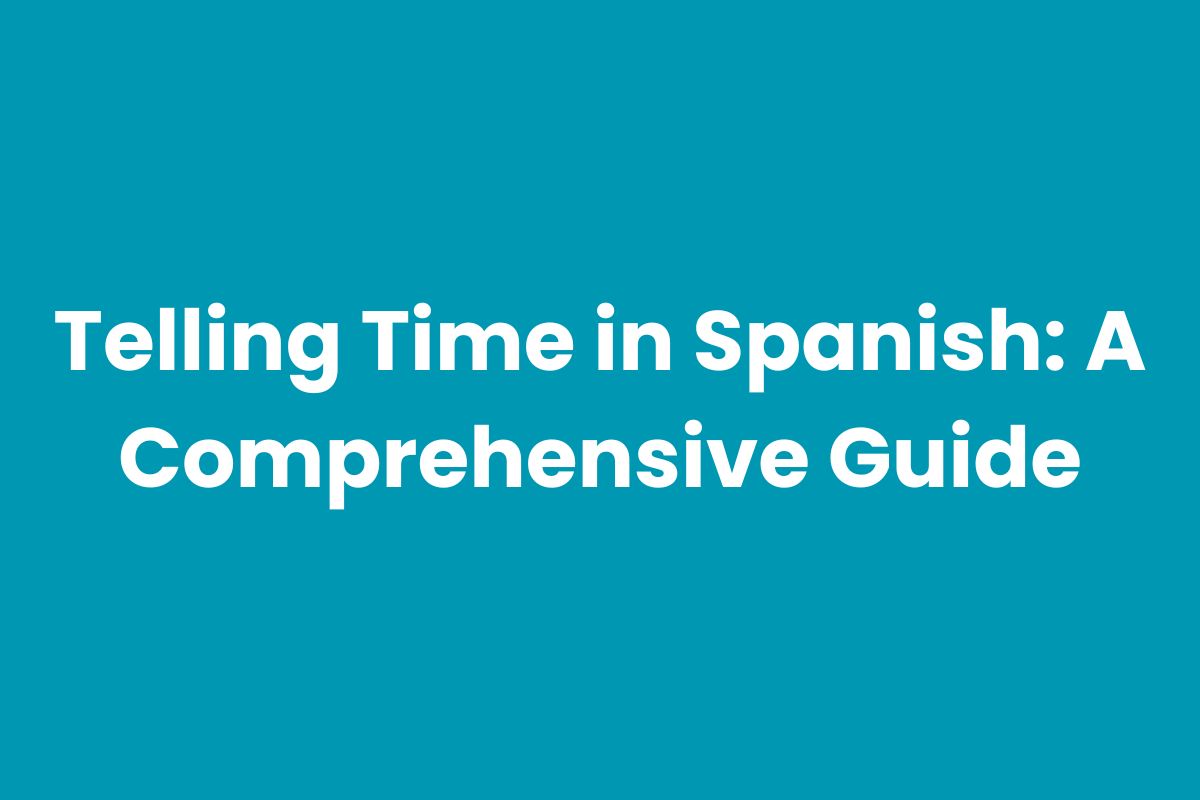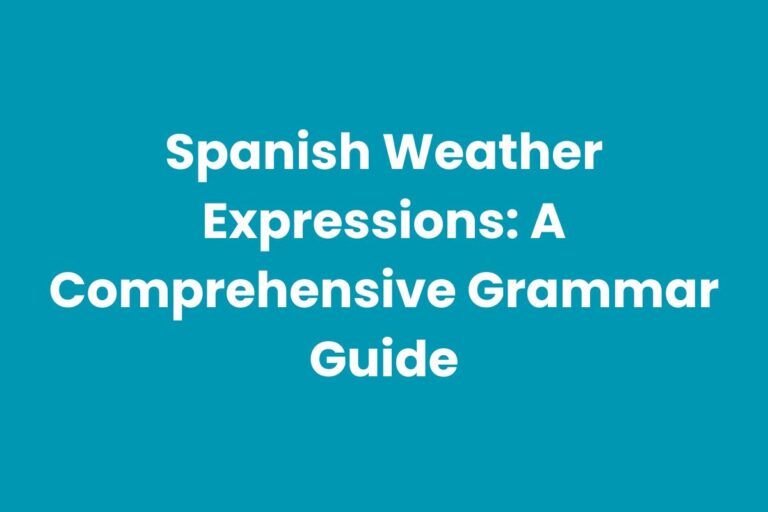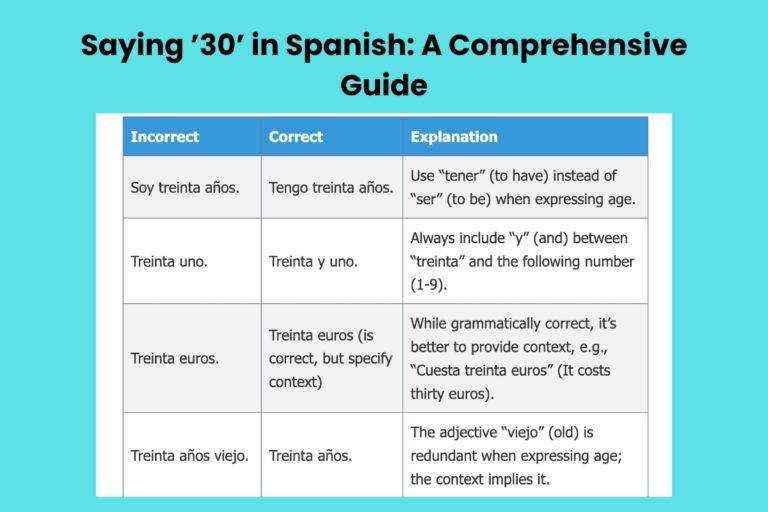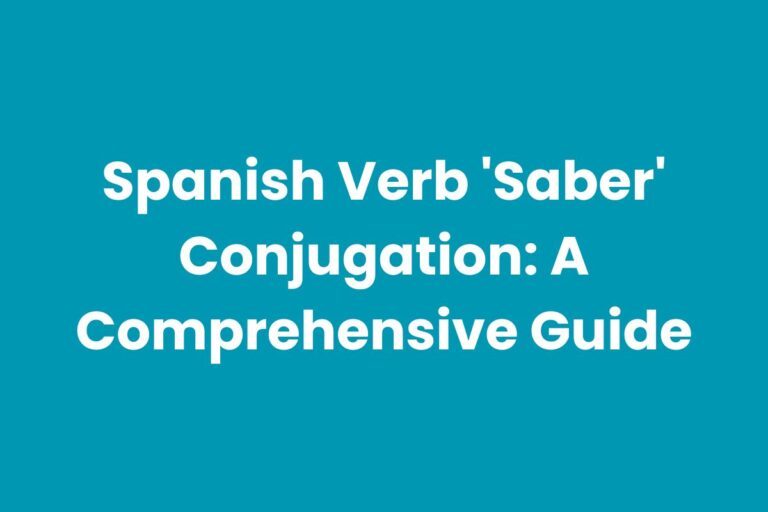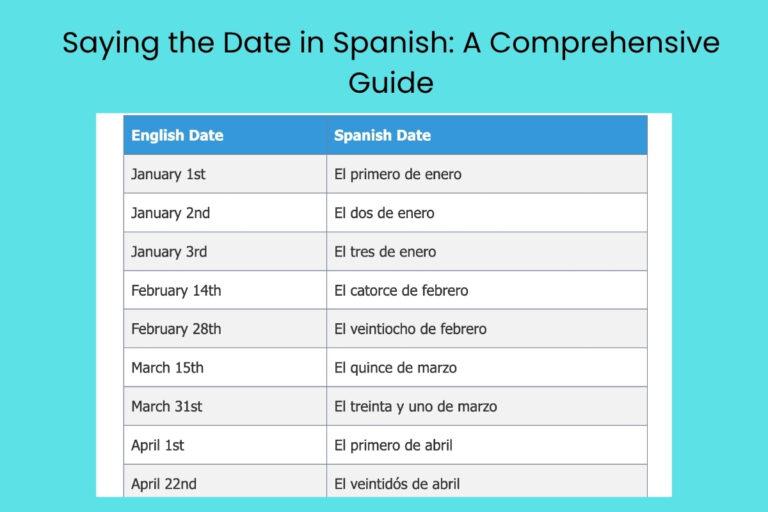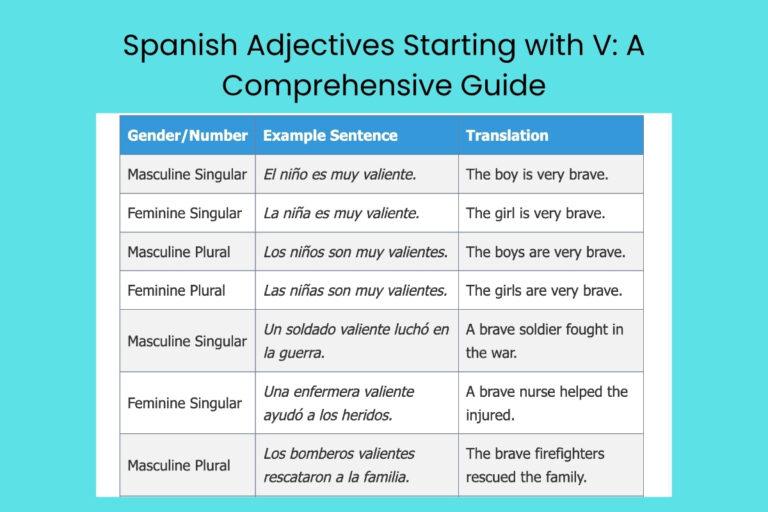Telling Time in Spanish: A Comprehensive Guide
Mastering how to tell time in Spanish is crucial for everyday communication, whether you’re scheduling appointments, making travel plans, or simply chatting with native speakers. This skill unlocks a deeper understanding of Spanish grammar and culture, allowing you to navigate daily life with confidence.
This guide is designed for learners of all levels, from beginners to advanced speakers, providing a structured approach to understanding and using time expressions in Spanish. By the end of this article, you’ll be able to accurately tell time, ask about time, and discuss schedules in Spanish.
Table of Contents
- Introduction
- Definition: Telling Time in Spanish
- Structural Breakdown
- Types and Categories of Time Expressions
- Examples
- Usage Rules
- Common Mistakes
- Practice Exercises
- Advanced Topics
- FAQ
- Conclusion
Definition: Telling Time in Spanish
Telling time in Spanish involves using specific grammatical structures and vocabulary to express the hour, minutes, and time of day. It’s more than just translating numbers; it requires understanding the proper use of verbs like ser (to be) and prepositions like a and de. The function of telling time is to communicate specific points in the 24-hour cycle, schedule events, and coordinate activities. The contexts in which you’ll use this skill range from casual conversations with friends to formal business meetings.
The core components include knowing the numbers in Spanish, understanding how to express “o’clock,” “quarter past,” “half past,” and “quarter to,” and being familiar with phrases that indicate morning, afternoon, and night. Mastering this skill is essential for effective communication in any Spanish-speaking environment.
Structural Breakdown
The basic structure for telling time in Spanish revolves around the verb ser (to be). For one o’clock, we use the singular form es, while for all other hours, we use the plural form son. The structure generally follows this pattern:
Es/Son + la/las + hour + y/menos + minutes
Here’s a breakdown:
- Es/Son: The verb “to be” conjugated in the third-person singular (es) or plural (son).
- La/Las: The definite article “the,” singular (la) for one o’clock and plural (las) for all other hours.
- Hour: The number corresponding to the hour.
- Y/Menos: “And” (y) is used to add minutes to the hour. “Minus” (menos) is used to subtract minutes from the upcoming hour.
- Minutes: The number corresponding to the minutes.
For example:
- Es la una (It’s one o’clock).
- Son las dos y quince (It’s two fifteen).
- Son las tres menos cuarto (It’s a quarter to three).
Types and Categories of Time Expressions
Exact Time
Expressing exact time involves stating the hour and minutes precisely. This is useful for schedules, appointments, and any situation where precision is needed. For example, Son las cinco y treinta y dos minutos (It’s five thirty-two).
Approximate Time
Sometimes, an approximate time is sufficient. This can be achieved by using phrases like alrededor de (around), cerca de (close to), or simply rounding to the nearest five or ten minutes. For example, Son alrededor de las seis (It’s around six o’clock).
Time in Relation to Activities
You can also express time in relation to activities, such as a la hora del almuerzo (at lunchtime) or antes de la cena (before dinner). This is common in everyday conversation and helps to provide context to the time being discussed.
Examples
Telling the Hour
When telling the hour, remember to use es la for one o’clock and son las for all other hours. Here are some examples:
The following table illustrates various examples of stating the hour in Spanish:
| English | Spanish |
|---|---|
| It’s one o’clock. | Es la una. |
| It’s two o’clock. | Son las dos. |
| It’s three o’clock. | Son las tres. |
| It’s four o’clock. | Son las cuatro. |
| It’s five o’clock. | Son las cinco. |
| It’s six o’clock. | Son las seis. |
| It’s seven o’clock. | Son las siete. |
| It’s eight o’clock. | Son las ocho. |
| It’s nine o’clock. | Son las nueve. |
| It’s ten o’clock. | Son las diez. |
| It’s eleven o’clock. | Son las once. |
| It’s twelve o’clock. | Son las doce. |
| It’s one o’clock (PM). | Es la una de la tarde. |
| It’s two o’clock (PM). | Son las dos de la tarde. |
| It’s three o’clock (AM). | Son las tres de la mañana. |
| It’s four o’clock (AM). | Son las cuatro de la mañana. |
| It’s five o’clock (PM). | Son las cinco de la tarde. |
| It’s six o’clock (PM). | Son las seis de la tarde. |
| It’s seven o’clock (PM). | Son las siete de la noche. |
| It’s eight o’clock (PM). | Son las ocho de la noche. |
| It’s nine o’clock (PM). | Son las nueve de la noche. |
| It’s ten o’clock (PM). | Son las diez de la noche. |
| It’s eleven o’clock (PM). | Son las once de la noche. |
| It’s twelve o’clock (AM/midnight). | Es la doce de la noche / Es la medianoche. |
Telling the Minutes
To tell the minutes past the hour, use y (and) followed by the number of minutes. For example:
The table below provides a comprehensive list of examples for telling the minutes past the hour in Spanish:
| English | Spanish |
|---|---|
| It’s one oh five. | Es la una y cinco. |
| It’s two ten. | Son las dos y diez. |
| It’s three fifteen. | Son las tres y quince. |
| It’s four twenty. | Son las cuatro y veinte. |
| It’s five twenty-five. | Son las cinco y veinticinco. |
| It’s six thirty. | Son las seis y treinta. |
| It’s seven thirty-five. | Son las siete y treinta y cinco. |
| It’s eight forty. | Son las ocho y cuarenta. |
| It’s nine forty-five. | Son las nueve y cuarenta y cinco. |
| It’s ten fifty. | Son las diez y cincuenta. |
| It’s eleven fifty-five. | Son las once y cincuenta y cinco. |
| It’s one thirty-one. | Es la una y treinta y uno. |
| It’s two seventeen. | Son las dos y diecisiete. |
| It’s three twenty-two. | Son las tres y veintidós. |
| It’s four twenty-eight. | Son las cuatro y veintiocho. |
| It’s five thirty-three. | Son las cinco y treinta y tres. |
| It’s six thirty-nine. | Son las seis y treinta y nueve. |
| It’s seven forty-four. | Son las siete y cuarenta y cuatro. |
| It’s eight fifty-one. | Son las ocho y cincuenta y uno. |
| It’s nine fifty-seven. | Son las nueve y cincuenta y siete. |
| It’s ten fourteen. | Son las diez y catorce. |
Using “y” and “menos”
Spanish uses both addition (y) and subtraction (menos) to express time. After the half-hour, it’s common to count down to the next hour using menos. For example, instead of saying “Son las dos y cuarenta,” you can say “Son las tres menos veinte” (It’s twenty to three). This is a very common and useful construct.
The following table presents a series of examples demonstrating the use of “y” and “menos” when telling time:
| English | Spanish (Using “y”) | Spanish (Using “menos”) |
|---|---|---|
| It’s five twenty. | Son las cinco y veinte. | Son las seis menos cuarenta. |
| It’s six twenty-five. | Son las seis y veinticinco. | Son las siete menos treinta y cinco. |
| It’s seven thirty-five. | Son las siete y treinta y cinco. | Son las ocho menos veinticinco. |
| It’s eight forty. | Son las ocho y cuarenta. | Son las nueve menos veinte. |
| It’s nine forty-five. | Son las nueve y cuarenta y cinco. | Son las diez menos cuarto. |
| It’s ten fifty. | Son las diez y cincuenta. | Son las once menos diez. |
| It’s eleven fifty-five. | Son las once y cincuenta y cinco. | Son las doce menos cinco. |
| It’s one thirty-five. | Es la una y treinta y cinco. | Son las dos menos veinticinco. |
| It’s two forty. | Son las dos y cuarenta. | Son las tres menos veinte. |
| It’s three forty-five. | Son las tres y cuarenta y cinco. | Son las cuatro menos cuarto. |
| It’s four fifty. | Son las cuatro y cincuenta. | Son las cinco menos diez. |
| It’s five fifty-five. | Son las cinco y cincuenta y cinco. | Son las seis menos cinco. |
| It’s six ten. | Son las seis y diez. | Son las siete menos cincuenta. |
| It’s seven fifteen. | Son las siete y quince. | Son las ocho menos cuarenta y cinco. |
| It’s eight twenty. | Son las ocho y veinte. | Son las nueve menos cuarenta. |
| It’s nine twenty-five. | Son las nueve y veinticinco. | Son las diez menos treinta y cinco. |
| It’s ten thirty. | Son las diez y treinta. | Son las once menos treinta. |
| It’s eleven thirty-five. | Son las once y treinta y cinco. | Son las doce menos veinticinco. |
| It’s twelve forty. | Son las doce y cuarenta. | Es la una menos veinte. |
| It’s one forty-five. | Es la una y cuarenta y cinco. | Son las dos menos cuarto. |
Time of Day
To specify the time of day, you can add de la mañana (in the morning), de la tarde (in the afternoon/evening), or de la noche (at night). The divisions are generally:
- De la mañana: From sunrise to noon (approximately 6:00 AM to 12:00 PM)
- De la tarde: From noon to sunset (approximately 12:00 PM to 6:00 PM)
- De la noche: From sunset to sunrise (approximately 6:00 PM to 6:00 AM)
Here are some examples:
- Son las ocho de la mañana. (It’s eight in the morning.)
- Es la una de la tarde. (It’s one in the afternoon.)
- Son las diez de la noche. (It’s ten at night.)
This table lists examples that include the time of day to provide more context:
| English | Spanish |
|---|---|
| It’s 7:00 AM. | Son las siete de la mañana. |
| It’s 10:00 AM. | Son las diez de la mañana. |
| It’s 1:00 PM. | Es la una de la tarde. |
| It’s 3:00 PM. | Son las tres de la tarde. |
| It’s 6:00 PM. | Son las seis de la tarde. |
| It’s 8:00 PM. | Son las ocho de la noche. |
| It’s 11:00 PM. | Son las once de la noche. |
| It’s 12:00 AM (midnight). | Es la medianoche. / Son las doce de la noche. |
| It’s 2:00 AM. | Son las dos de la mañana. |
| It’s 4:30 PM. | Son las cuatro y media de la tarde. |
| It’s 9:15 AM. | Son las nueve y cuarto de la mañana. |
| It’s 7:45 PM. | Son las ocho menos cuarto de la noche. |
| It’s 1:10 AM. | Es la una y diez de la mañana. |
| It’s 5:20 PM. | Son las cinco y veinte de la tarde. |
| It’s 10:55 PM. | Son las once menos cinco de la noche. |
| It’s 6:30 AM. | Son las seis y media de la mañana. |
| It’s 3:50 PM. | Son las cuatro menos diez de la tarde. |
| It’s 8:05 PM. | Son las ocho y cinco de la noche. |
| It’s 12:15 PM. | Son las doce y cuarto de la tarde. |
| It’s 11:40 AM. | Son las doce menos veinte de la mañana. |
Usage Rules
“Es” vs. “Son”
The most important rule is remembering to use es la for one o’clock and son las for all other hours. This is because la una is singular, while all other hours are plural.
“De la mañana,” “de la tarde,” “de la noche”
These phrases are essential for specifying the time of day. While the general divisions are as stated above, context can sometimes shift the boundaries. For example, 6:00 PM might be considered de la tarde or de la noche depending on the season and location.
Formal vs. Informal Usage
While the structures remain the same, formality can influence the precision of the time you give. In formal settings, giving the exact minute is appropriate.
In informal settings, rounding to the nearest five minutes or using approximations is common.
Common Mistakes
One common mistake is using es with hours other than one. For example, saying Es las dos is incorrect; it should be Son las dos.
Another mistake is forgetting the definite article (la/las). You must say Es *la* una or Son *las* tres. Omitting the article is a common error among beginners.
Finally, confusing y and menos is a frequent error. Remember that y adds minutes to the current hour, while menos subtracts minutes from the upcoming hour. For example, saying Son las seis menos veinte when you mean 6:20 is incorrect.
Here’s a table illustrating common mistakes and their corrections:
| Incorrect | Correct | Explanation |
|---|---|---|
| Es las dos. | Son las dos. | “Es” is only used for 1 o’clock (Es la una). |
| Son dos. | Son las dos. | The definite article “las” is required before the hour. |
| Es la cinco y media. | Son las cinco y media. | “Es” is only for 1 o’clock. Use “Son” for all other hours. |
| Son las ocho menos veinticinco de la mañana. (Intending 7:35 AM) | Son las siete y treinta y cinco de la mañana. / Son las ocho menos veinticinco de la mañana. | Be clear whether you are adding to the current hour or subtracting from the next. |
| Tengo una cita a la una. (Missing context) | Tengo una cita a la una de la tarde. (If it’s 1 PM) | Specify “de la mañana,” “de la tarde,” or “de la noche” for clarity. |
| Es doce de la mañana. | Es mediodía. / Son las doce de la mañana. | “Mediodía” is the correct term for noon. |
| Es doce de la noche. | Es medianoche. / Son las doce de la noche. | “Medianoche” is the correct term for midnight. |
| Qué hora es? | ¿Qué hora es? | Remember to use the inverted question mark at the beginning of the question. |
| A qué hora es la fiesta? | ¿A qué hora es la fiesta? | Inverted question mark is needed. |
| La una y media. | Es la una y media. | The verb “es” is needed to form a complete sentence. |
Practice Exercises
Convert the following times from English to Spanish:
| Question | Answer |
|---|---|
| 1. 3:15 PM | Son las tres y cuarto de la tarde. |
| 2. 7:30 AM | Son las siete y media de la mañana. |
| 3. 10:45 PM | Son las once menos cuarto de la noche. |
| 4. 1:00 PM | Es la una de la tarde. |
| 5. 6:20 AM | Son las seis y veinte de la mañana. |
| 6. 11:55 PM | Son las doce menos cinco de la noche. |
| 7. 9:05 AM | Son las nueve y cinco de la mañana. |
| 8. 4:50 PM | Son las cinco menos diez de la tarde. |
| 9. 2:35 AM | Son las tres menos veinticinco de la mañana. |
| 10. 12:00 PM (noon) | Es mediodía. / Son las doce de la tarde. |
Write the following times in Spanish using both “y” and “menos” where applicable:
| Question | Answer (Using “y”) | Answer (Using “menos”) |
|---|---|---|
| 1. 6:10 | Son las seis y diez. | Son las siete menos cincuenta. |
| 2. 8:25 | Son las ocho y veinticinco. | Son las nueve menos treinta y cinco. |
| 3. 10:40 | Son las diez y cuarenta. | Son las once menos veinte. |
| 4. 1:55 | Es la una y cincuenta y cinco. | Son las dos menos cinco. |
| 5. 3:15 | Son las tres y quince. | Son las cuatro menos cuarenta y cinco. |
| 6. 5:30 | Son las cinco y treinta. | Son las seis menos treinta. |
| 7. 7:45 | Son las siete y cuarenta y cinco. | Son las ocho menos cuarto. |
| 8. 9:00 | Son las nueve. | Son las nueve. |
| 9. 11:20 | Son las once y veinte. | Son las doce menos cuarenta. |
| 10. 2:05 | Son las dos y cinco. | Son las tres menos cincuenta y cinco. |
Translate the following questions and answers into English:
| Spanish | English |
|---|---|
| 1. ¿Qué hora es? Son las cuatro de la tarde. | What time is it? It’s four in the afternoon. |
| 2. ¿A qué hora es la clase? Es a las nueve de la mañana. | What time is the class? It’s at nine in the morning. |
| 3. ¿Tienes tiempo? Sí, son las dos y media. | Do you have time? Yes, it’s two thirty. |
| 4. ¿A qué hora te levantas? Me levanto a las seis de la mañana. | What time do you get up? I get up at six in the morning. |
| 5. ¿Cuándo es la reunión? Es a las once menos cuarto de la mañana. | When is the meeting? It’s at a quarter to eleven in the morning. |
| 6. ¿A qué hora empieza la película? Empieza a las siete y veinte de la noche. | What time does the movie start? It starts at twenty past seven in the evening. |
| 7. ¿Es temprano o tarde? Es temprano, son las ocho de la mañana. | Is it early or late? It’s early, it’s eight in the morning. |
| 8. ¿A qué hora cenamos? Cenamos a las nueve de la noche. | What time do we have dinner? We have dinner at nine in the evening. |
| 9. ¿Cuánto tiempo falta? Falta media hora. | How much time is left? Half an hour is left. |
| 10. ¿A qué hora terminas de trabajar? Termino a las cinco y media de la tarde. | What time do you finish work? I finish at half past five in the afternoon. |
Advanced Topics
Time Zones
When discussing time with people in different locations, understanding time zones is crucial. You can ask about the time in another location by saying, ¿Qué hora es en [location]? (What time is it in [location]?). Be prepared to adjust your time accordingly.
Daylight Savings Time
Daylight Savings Time (DST), or horario de verano, can affect how you tell time. Remember to adjust your clocks forward in the spring and backward in the fall. Different countries observe DST at different times, so it’s essential to be aware of the local customs.
Idiomatic Expressions with Time
Spanish has many idiomatic expressions involving time. Some examples include:
- A tiempo: On time
- De vez en cuando: From time to time
- En un abrir y cerrar de ojos: In the blink of an eye
Learning these expressions can enrich your understanding of the language and make your conversations more natural.
FAQ
- How do I ask what time it is in Spanish?
You can ask “¿Qué hora es?” (What time is it?) or “¿Tiene(s) hora?” (Do you have the time?). The first is more direct, while the second is a more polite way to ask someone for the time. - How do I say “half past” in Spanish?
You can say “y media” (and a half). For example, “Son las dos y media” means “It’s half past two.” - What is the difference between “de la tarde” and “de la noche“?
“De la tarde” is used for the afternoon/evening, generally from noon until sunset (around 6:00 PM). “De la noche” is used for the night, from sunset until sunrise (around 6:00 AM). However, the exact time can vary depending on the region and season. - How do I say “a quarter past” in Spanish?
You can say “y cuarto” (and a quarter). For example, “Son las tres y cuarto” means “It’s a quarter past three.” - How do I say “a quarter to” in Spanish?
You can say “menos cuarto” (minus a quarter). For example, “Son las cuatro menos cuarto” means “It’s a quarter to four.” - Is it necessary to always include “de la mañana,” “de la tarde,” or “de la noche“?
Not always, but it’s helpful for clarity, especially - Is it necessary to always include “de la mañana,” “de la tarde,” or “de la noche“?
Not always, but it’s helpful for clarity, especially if the context doesn’t make it obvious. If you’re making plans for the evening, it’s understood that you’re talking about de la noche. However, if there’s any ambiguity, it’s best to include the time of day. - How do I express duration in Spanish?
You can use phrases like “durante” (during), “por” (for), or specify a time period, such as “una hora” (one hour) or “quince minutos” (fifteen minutes). For example, “La reunión duró dos horas” (The meeting lasted two hours). - What’s the best way to practice telling time in Spanish?
Use flashcards, online quizzes, or language learning apps that focus on time. Practice with a native speaker or language partner, and try to incorporate time-telling into your daily routine. For example, check the time in Spanish throughout the day. - Are there regional variations in how time is expressed?
Yes, there can be slight regional variations. While the basic structure remains the same, some regions may prefer certain expressions over others. Listening to native speakers from different regions can help you become familiar with these variations. - How do I say “noon” and “midnight” in Spanish?
“Noon” is “mediodía,” and “midnight” is “medianoche.” You can also say “las doce de la tarde” for noon and “las doce de la noche” for midnight.
Conclusion
Telling time in Spanish is a fundamental skill that enhances your ability to communicate effectively in Spanish-speaking environments. By understanding the basic structures, usage rules, and common expressions, you can confidently discuss schedules, make appointments, and engage in everyday conversations.
Remember to practice regularly and pay attention to the nuances of the language. With consistent effort, you’ll master this essential aspect of Spanish and further enrich your linguistic abilities.

